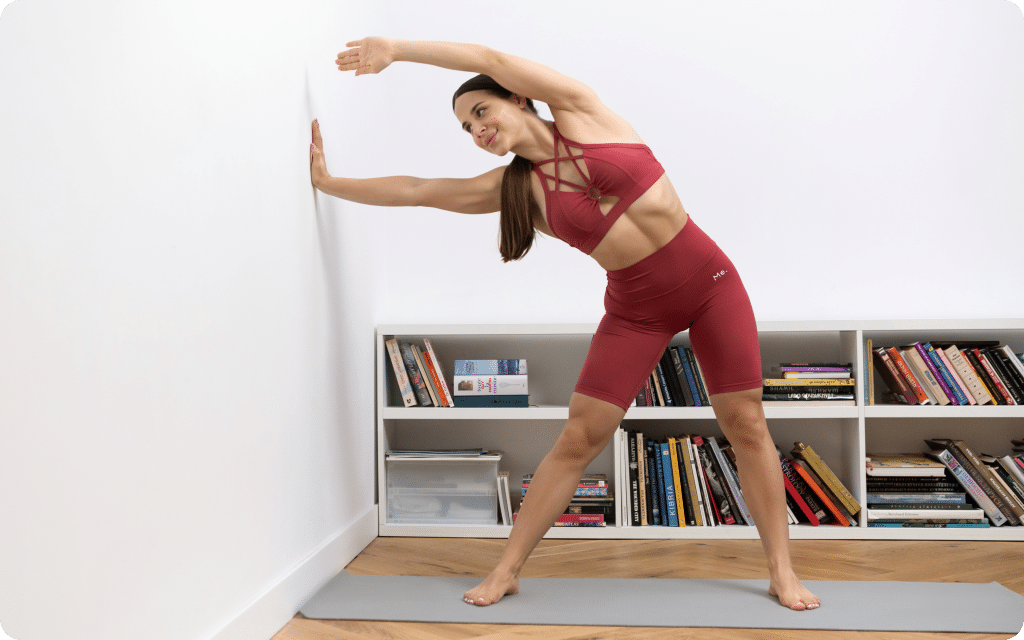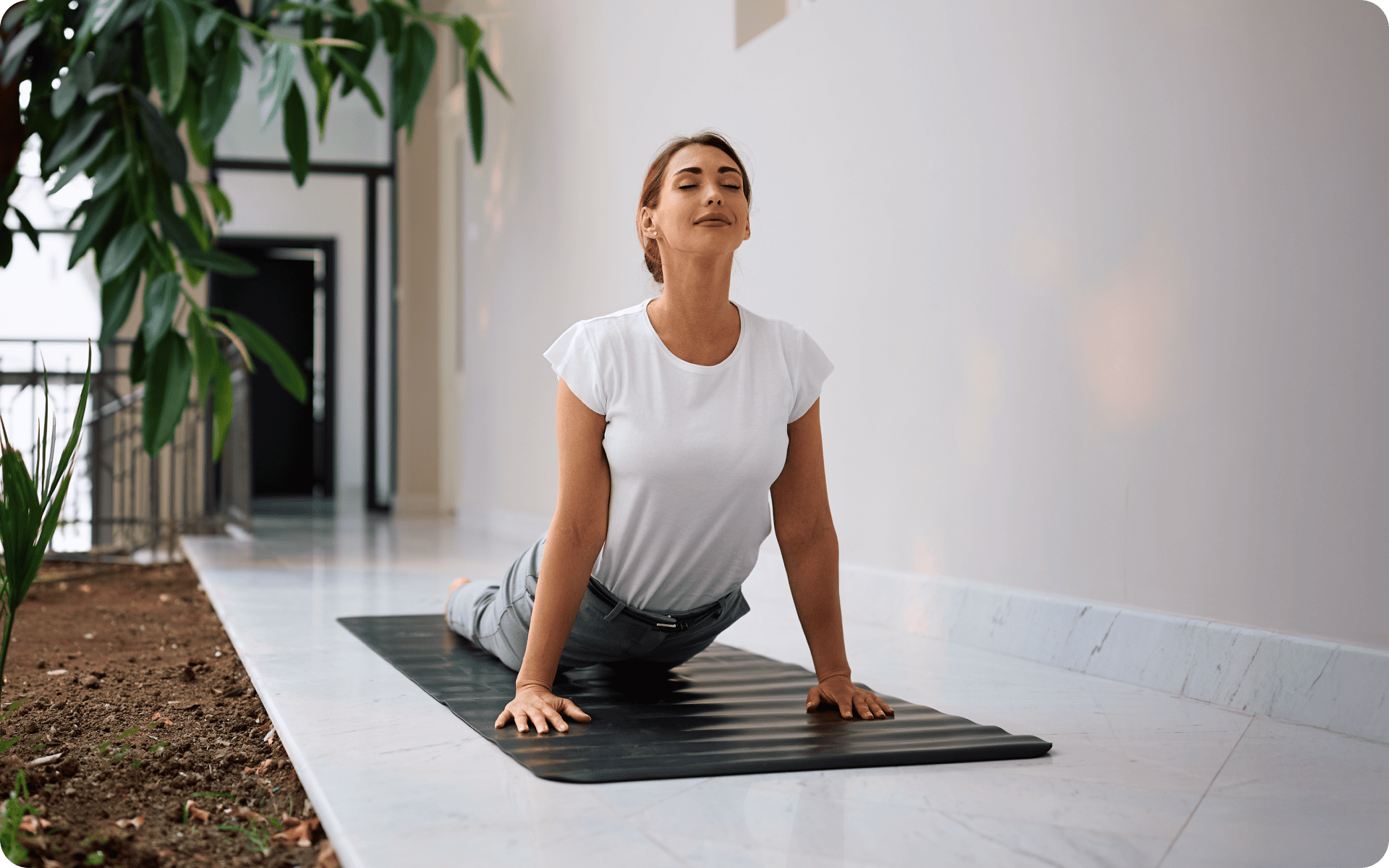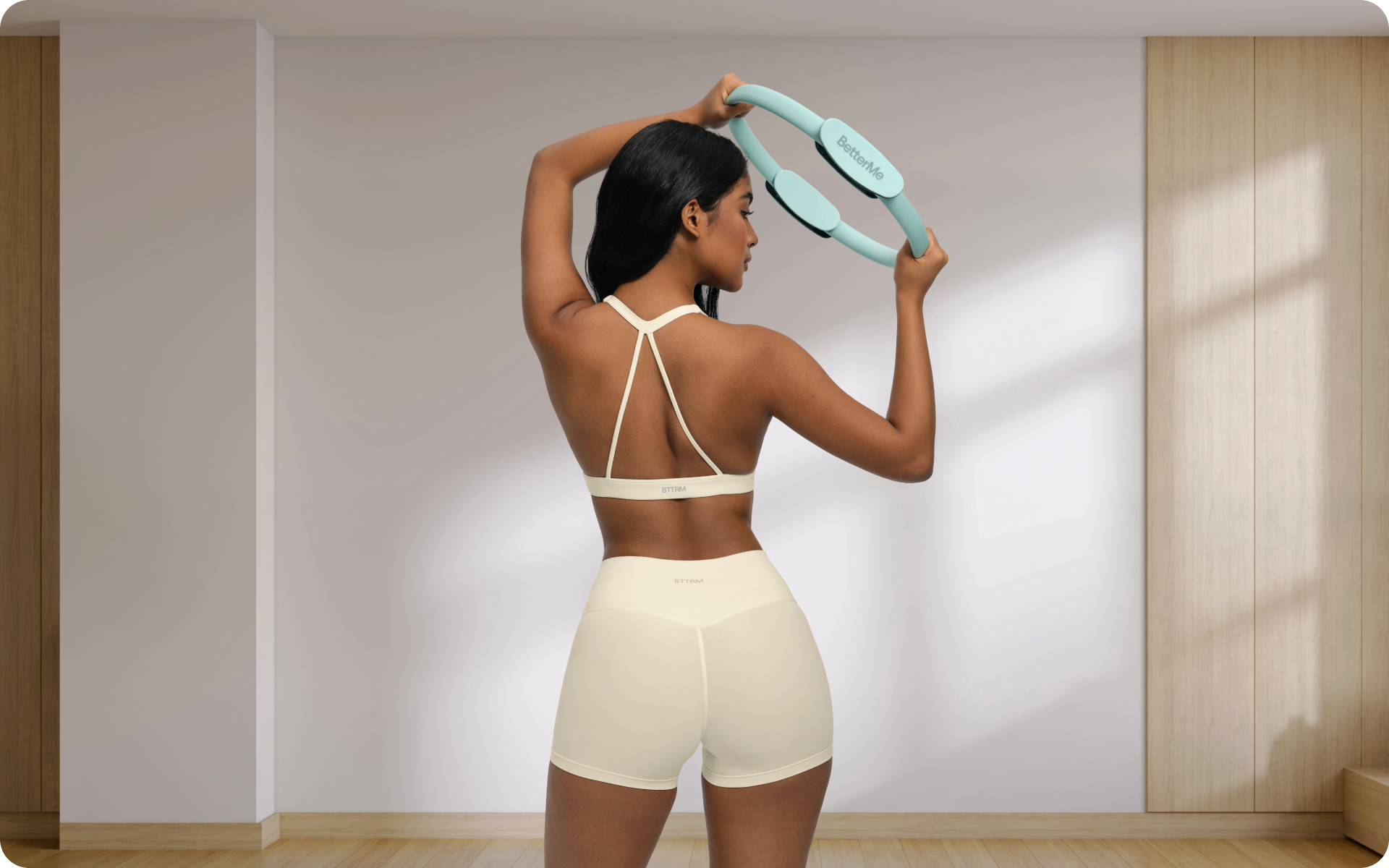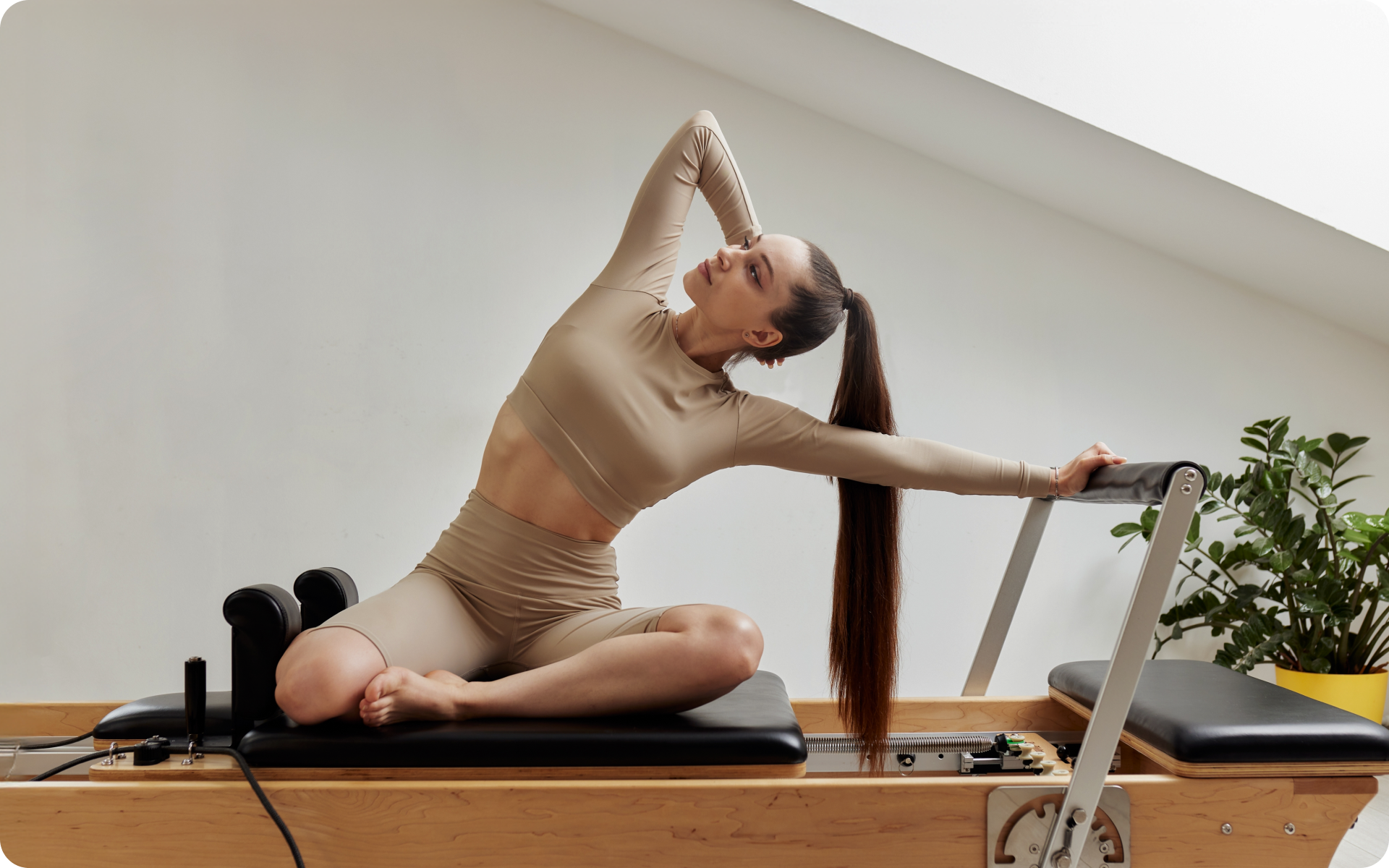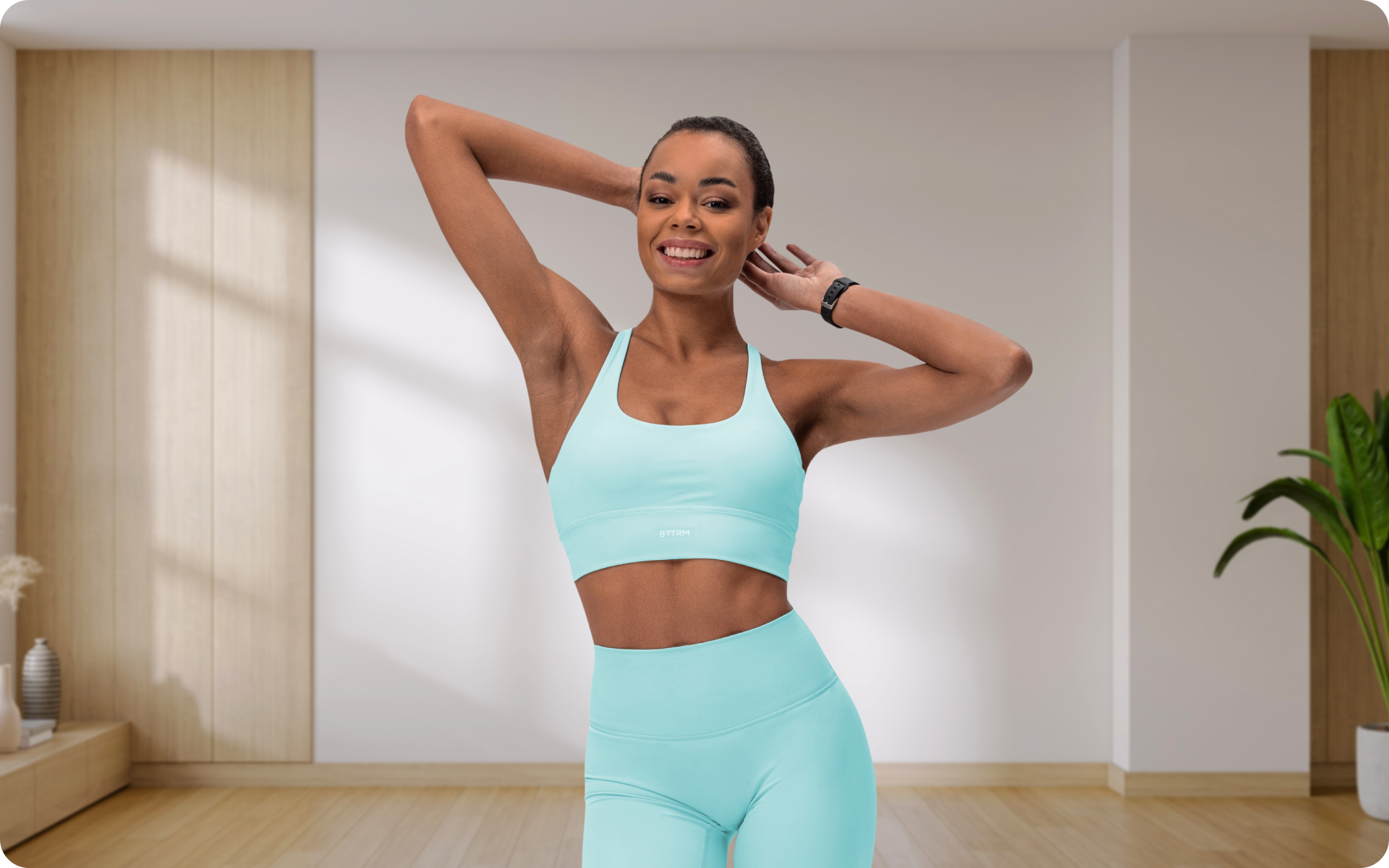Searching for the props in online or offline stores can be tiring. Making the regular trip to local Pilates sessions can also be a challenge.
Just thinking about it your options probably makes you want to binge watch something in your playlist, or just scroll social media on your phone.
If you’re one of those people who prefers doing home workouts and not searching for any props, Wall Pilates is your ideal choice. Pilates exercises against a wall are growing in popularity as the only prop for this activity is already in your house – your wall.
Wall Pilates means you engage in typical Pilates exercises using a wall as your resistance prop, whether squats, glute bridges, push-ups, etc.
Doing wall exercises in good form and technique gives you the chance to reap essential benefits.
For sure, attending a Pilates session would be better – your instructor would keep tabs on your movements and improve your body alignment. That said, there are beginner-friendly Pilates regimes you could start with on your own.
Pilates against the wall for beginners and advanced masters is a perfect combination of practical workouts and a well-established resistance.
Why is Pilates against the wall beneficial for you? To know the answers, continue reading!
How to do pilates against the wall?
We’ve prepared 6 Pilates against-the-wall at-home workouts. If you’re a senior, don’t look away, as we included an additional 4 Pilates against the wall for seniors exercises.
What does this mean? – Everyone can enjoy Pilates. Let’s get into the workouts.
- Wall-Assisted Bridges
- Wall Squats With Arm Lifts
- Wall Marches With Straight Legs
- Wall Push-Ups
- Wall Sits
- Wall Lunge Pulses
Now for seniors:
- Wall single-leg lifts
- Wall Shoulder Stretches
- Wall Spine Stretch
- Pilates Plank at the Wall
Lean and toned up body isn’t just a far-fetched fantasy. Check out the BetterMe app and watch it propel your weight loss journey into high gear!
Wall-Assisted Bridges
- Lie on your back, place your feet on the wall, with your knees over your hips.
- Keep your knees bent and your calves parallel to the floor, with your feet slightly higher than your knees.
- Pressing into the wall with your feet lift your hips into a bridge position.
- Drop the hips back down.
- Repeat two sets for 8-12 times.
Wall Squats With Arm Lifts
- Press your back into the wall and walk your feet out in front of you.
- Slide your back down the wall and get in a squat position with your knees bent and your ankles under your knees.
- Do a squat lifting your arms out in front of you and up overhead, then reverse, and repeat.
- Repeat two sets for 10-14 times.
Wall Marches With Straight Legs
- From the bridge position, walk your feet up the wall until your knees are straight.
- Lift the right leg off the wall and sweep it up towards your head.
- Return the right leg to the wall, then repeat with the left leg.
- Continue to switch legs.
- Repeat two sets for 8-12 times.
Wall Push-Ups
- Press your hands into a wall about shoulder distance apart.
- Step your feet back. (The further your feet are from the wall, the more it will burn.)
- Lower yourself towards the wall, with your elbows in at a 45-degree angle.
- Pressing into the wall rise back up.
- Aim for four sets of 10 reps.
Wall Sits
- Lean your back against a wall and slide your bum down until your knees are at 90 degrees.
- Pressing your back into the wall, engage your glutes, quads, and hamstrings to stay steady.
- Hold anywhere from 10 to 60 seconds and repeat three times.
Wall Lunge Pulses
- Stand upright with your back facing the wall.
- Take a big step with your right leg.
- As you bend the right leg, lift a bent left leg behind you toward the wall, and put the left foot on the wall.
- Keep your hands on your hips.
- Pulse the right leg, bend slightly, and then return to the starting bend.
- Repeat on the other side.
- Do at least two sets for 8-12 times.
A senior’s version of Wall Pilates:
Wall single-leg lifts
- Stand with your side to the wall and place one hand on the wall for support.
- Lift one leg out to the side, keeping it in line with your body.
- Lower the leg back down and repeat.
- Repeat two sets for 5-8 times.
Wall Shoulder Stretches
- Face the wall, extend your arms, and place your palms on the wall.
- Lean forward, and have your chest move closer to the wall while keeping your arms straight.
- Hold the stretch for 20-30 seconds, then release.
- Do 2-3 repetitions.
Read more: Wall Pilates for Butt: A Quick Guide for Beginners
Wall Spine Stretch
- Stand with your back against the wall and your feet hip-width apart. Slightly bend your knees.
- Roll down through your spine and bring your chin to your chest.
- When your hands reach the wall, gently roll back up to the starting position.
- Repeat for 8-10 repetitions.
Pilates Plank at the Wall
- Stand straight, facing the wall, and placing your hands on the wall at shoulder height.
- Step back, creating a straight line from your head to your heels.
- Hold the plank position for 20-30 seconds, maintaining proper form and engaging your core.
- Repeat for 2-3 repetitions.
Being a senior doesn’t deprive you of the aforementioned 6 Wall Pilates exercises. That said, you need to do it slowly without pressuring your body. Listen to your body.
There are two keys to a successful Pilates workout: maintaining proper technique and listening to your body.
What are the benefits of pilates against the wall?
There are 7 major Pilates against the wall benefits.
It’s a full-body workout
Wall Pilates engages different muscle groups, providing an intense full-body workout. You’ll train your legs, core, arms, and back, resulting in a more toned and balanced physique.
It’s a great stability workout
The wall will give you the support that you need, especially if you tend to wobble. As you feel stable, you’re more likely to perform the exercises with proper form, and thus the more effective they’ll be.
It’s free resistance training
You don’t need to purchase any equipment. The wall can provide an extra challenge that you wouldn’t get on a mat alone. The resistance from the wall can intensify the engagement of your core during the Pilates movements.
It’s a winning prop for your alignment
For instance, when you lie against the wall on your side, you can use the wall to determine whether you are fully straight or not. The same applies to standing which makes it great for practicing at home without the Pilates instructor.
It’s a free workout that promotes your flexibility and range of motion
Stretching keeps your fibers flexible, decreasing your risk of injury.
Flexibility along with strength training helps you feel younger again. These moves don’t only strengthen the muscles around your hips, quads, and hamstrings, they also promote improved function in these muscles, contributing to increased overall movement mechanics. (1).
Wall Pilates is a perfect mix of strength and flexibility in one workout, giving you the best of both worlds.
It’s a training that may decrease your back pain
Practicing floor or Wall Pilates regularly might reduce any pain in your back.
Studies have shown that Pilates can improve back pain issues and body functioning, as well as promote overall quality of life. That said, using it as an additional remedy for back pain is beneficial (3).
It’s a muscle mass-increasing activity
A review of nine studies highlights that Pilates can increase muscle mass and decrease body fat mass in overweight individuals. (4).
Yet, more research is needed to support Wall Pilates in particular.
Additionally, some people combine Wall Yoga with Wall Pilates.
Looking for a way to break the vicious cycle of weight loss and tone up all the jiggly parts? Watch the extra pounds fly off and your muscles firm up with the BetterMe app!
How many times a week should you do Wall Pilates?
It’s personal for everyone. If you’re just starting your Wall Pilates routine, do it 2 to 3 times a week. As you progress and learn to maintain proper form and technique, you may switch to 4-5 days per week of Pilates workout against the wall.
The right thing to do is to not over-challenge yourself by engaging in advanced practices. Do the Wall Pilates for the newbies and gradually move on to advanced training.
Is Wall Pilates harder than regular Pilates?
Wall Piltes is slightly harder. The wall – the only prop you’re using during the Pilates practice can increase the intensity of the exercises. No wonder it turns out to be more challenging and effective.
With this in mind, you should begin your Pilates practice with simpler exercises as the wall will be providing you with more resistance. Of course, over time you’ll get stronger and more flexible and Wall Pilates will end up being as doable as the floor version.
For more stability and flexibility you may combine Wall Pilates with Wall Yoga.
How long does it take to see results from Wall Pilates?
This depends on what you mean by “results”. Do you want to become more flexible? Build more muscle? Or shed some pounds? Your goals here matter. Maybe you just want to stay active and just realize that Pilates is your ideal match.
If you’re a beginner who’s not engaged in any regular exercise, then yes, adding Wall Pilates to your routine will likely cause a positive effect.
Still, you should be burning more calories than you consume. A calorie deficit is essential for weight loss (2).
Changing your body condition level requires a more intense version of Pilates, like dynamic Pilates where adding extra weights and resistance bands is necessary.
More importantly, your consistency is key, as is progressing your workouts which gives your body new challenges.
Remember one rule: Your body needs some time to adapt. One research indicates that it takes around 6-10 weeks of persistent strength training to grow muscle. Besides, changes in your body composition are a mixture of different processes: sleep quality, genetics, hormones, stress levels, diet, and activity levels, as well as a calorie deficit (5).
Read more: Pilates Full Body Workout for Beginners (No Equipment Needed)
FAQs
Does Wall Pilates really work for weight loss?
Wall Pilates cannot help you drastically change your body composition. Yet, it may help you build and strengthen your muscles, and improve posture, balance, and alignment. Also, resistance from the wall helps you to not only burn calories but also create a toned and sculpted physique.
Can you do Wall Pilates everyday?
Doing Wall Pilates daily is not recommended for newbies. If you’ve done wall Pilates for a while, you can do it every day for 30 to 60 minutes. Remember to challenge yourself only as you get stronger. Rushing to advanced versions as a beginner will not be helpful and may harm your body instead.
Can Pilates change your body in 2 weeks?
No, Pilates can’t change your body in 2 weeks. Be skeptical of trainers and bloggers who promise fast results.
However, in two weeks you can build some habits and adjust to exercises. However noticeable results may be seen within 6 to 8 weeks. Your main duty here is to stay consistent and maintain proper form.
The Bottom Line
Why is Pilates against the wall beneficial for you?
You’ve reached the end of the article and are now aware of the 10 wall Pilates exercises for both younger adults and seniors.
Additionally, you’ve learned the 7 advantages of engaging in wall Pilates: being a full-body workout, wall Pilates is good for stability, body alignment, flexibility, and range of motion.
A Wall Pilates routine may also help decrease your headache and chronic pain, as well as promote building muscle mass.
You can enjoy this free resistance training at your home and use the wall as your basic resistance.
Wall Pilates will be more challenging than typical Pilates as wall resistance makes the activity more intense. If you’re consistent with your Pilates against the wall training, sleep well, and eat better food, you’ll notice results within 6 to 8 weeks.
DISCLAIMER:
This article is intended for general informational purposes only and does not serve to address individual circumstances. It is not a substitute for professional advice or help and should not be relied on for making any kind of decision-making. Any action taken as a direct or indirect result of the information in this article is entirely at your own risk and is your sole responsibility.
BetterMe, its content staff, and its medical advisors accept no responsibility for inaccuracies, errors, misstatements, inconsistencies, or omissions and specifically disclaim any liability, loss or risk, personal, professional or otherwise, which may be incurred as a consequence, directly or indirectly, of the use and/or application of any content.
You should always seek the advice of your physician or other qualified health provider with any questions you may have regarding a medical condition or your specific situation. Never disregard professional medical advice or delay seeking it because of BetterMe content. If you suspect or think you may have a medical emergency, call your doctor.
SOURCES:
- Acute and Chronic Effects of Supervised Flexibility Training in Older Adults: A Comparison of Two Different Conditioning Programs (2022, ncbi.nlm.nih.gov)
- Caloric Deficit: What to Know (2023, webmd.com)
- Efficacy of Pilates on Pain, Functional Disorders and Quality of Life in Patients with Chronic Low Back Pain: A Systematic Review and Meta-Analysis (2023, ncbi.nlm.nih.gov)
- Is the Pilates method efficient to cause changes in the body composition of healthy individuals? A systematic review (2022, sciencedirect.com)
- Maximizing Muscle Hypertrophy: A Systematic Review of Advanced Resistance Training Techniques and Methods (2019, ncbi.nlm.nih.gov)


